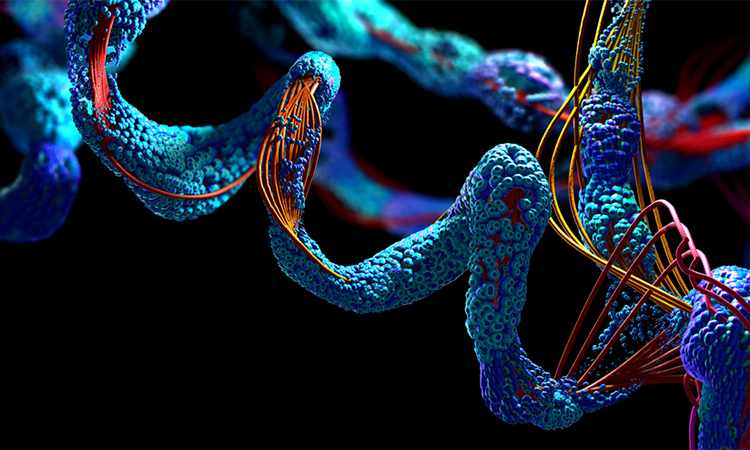Drug Target Review Ria Kakkad recently spoke with Victoria Goldenshtein about her lab’s novel in vitro The library display platform for directed protein evolution is called GRIP display – glue RNA to its protein.

In nature, proteins take millions and trillions of years to evolve1, but scientists don’t have that time when designing drugs for life-threatening diseases. Therefore, researchers use directed protein evolution techniques to evolve and design proteins with specific functions under well-defined conditions and realistic time frames.
At PEGS Europe, I interviewed Victoria Goldenshtein, a PhD candidate in biomedical engineering at Duke University in the US, who presented a fascinating poster about her lab novel in vitro A library display platform for directed protein evolution called GRIP Display requires RNA to be glued to its protein.
Motivation to develop new technology
“We developed GRIP Display with a very specific application in mind: optimizing the binding kinetics of a large protein with an already high affinity for its binding partner.2’” Goldenstein explained.
She also highlighted that existing directed protein evolution techniques have some limitations, thus necessitating the development of a new platform, explaining that “traditional methods cannot visualize large protein variants in a fixed maintain a stable link. Its encoded genetic material, which is required for protein identification.”
For example, in vivo Platforms (such as Phage Display) require bacterial transformation, causing a bottleneck of about 109 Variant, non-covalent genotype to phenotype in vitro The platform has been found to fall far short of the required connection stability, while the covalent in vitro The technique requires a multi-step chemical modification process to achieve a stable linkage between RNA and protein, resulting in a low-yield procedure3,4.
A Novel Platform for Directed Protein Evolution
To address these limitations, Goldenshtein and team developed GRIP Display, “a novel single-pot in vitro Display methods allow rapid generation and screening of rapid protein libraries (up to 10^14 variants) against any target of interest, including large proteins. With GRIP Display, she explained, the team was able to successfully modify a proprietary drug delivery technology called DART (Restricting Drugs Through Tethering), which rapidly localizes drugs to the surface of specific neurons in the brain.2
How do GRIP displays work?
“GRIP Display exploits high-affinity interactions between small peptide motifs and short RNA hairpin sequences borrowed from viruses. This interaction has previously been used in various applications, such as biochemical analysis and live-cell imaging, but not in The library showcases the environment,” Goldenshtein explained when asked about the capabilities of the technology. Conjugated mRNA serves as a unique identifier for each variant, enabling rapid identification of optimal binders for further characterization and development.
“However, displaying biologics in libraries poses a number of challenges, such as ensuring linkage fidelity for each mRNA molecule bound to its corresponding protein, and linkage stability over hours under various conditions.”
 At PEGS Europe, Victoria Goldenshtein presents a fascinating poster about her lab novel in vitro The library display platform for directed protein evolution is called GRIP Display.
At PEGS Europe, Victoria Goldenshtein presents a fascinating poster about her lab novel in vitro The library display platform for directed protein evolution is called GRIP Display.
To overcome these challenges, the team focused their efforts on technical optimization, resulting in a patent-pending three-dimensional mRNA design and improved affinity of the peptide-RNA tandem. This allows each individual mRNA to stick to its own protein without crosstalk or swapping with other RNA/protein pairs.
Next step
In addition to publishing the research, Goldenshtein hopes to validate the technology in clinically relevant areas, such as cancer therapy development using nanobodies, short antibody fragments and small peptides. Going forward, Goldenshtein hopes to focus on the general goal of targeting undruggable G protein-coupled receptors (GPCRs).
 victoria goldenstein is a trained analytical chemist. Her undergraduate research involved examining the affinity of zinc finger proteins for heavy metals. During her master’s degree, she joined Mathiowitz’s lab at Brown University, where she studied polymer nanoencapsulation and studied factors affecting the interaction of nanoparticles with mucins in the gastrointestinal tract to develop novel oral drug delivery systems . At Duke University, she was a PhD candidate in Tadross’ laboratory, focusing on improving drug delivery systems based on high-affinity biologics.
victoria goldenstein is a trained analytical chemist. Her undergraduate research involved examining the affinity of zinc finger proteins for heavy metals. During her master’s degree, she joined Mathiowitz’s lab at Brown University, where she studied polymer nanoencapsulation and studied factors affecting the interaction of nanoparticles with mucins in the gastrointestinal tract to develop novel oral drug delivery systems . At Duke University, she was a PhD candidate in Tadross’ laboratory, focusing on improving drug delivery systems based on high-affinity biologics.
refer to
- Agozzino L, Dill KA. The rate of protein evolution depends on its stability and abundance as well as the concentration of chaperones. Proceedings of the National Academy of Sciences. 2018;115(37):9092–7.
- Shields BC, Kahuno E, Kim C, and others. Deconstructing Cell-Specific Behavioral Neuropharmacology. science2017; 356(6333).
- Bhide M, Guillemin N, Comor L, and others. Library-Based Display Technology: Where Do We Stand? Molecular biological system. 2016;12(8):2342-2358. doi:10.1039/c6mb00219f
- Jijakli K, Khraiwesh B, Fu W, and others. this in vitro Choose world. method. 2016;106:3-13. doi:10.1016/j.ymeth.2016.06.003